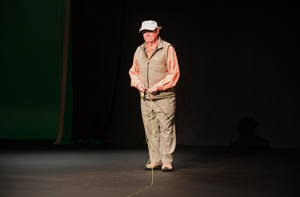can whip-out 130-feet of line on a breezy day. So if you’d like to be a better caster – keep on reading. Although it may seems to difficult to understand, no worry, each of the five essentials are accompanied by a graphic depiction that will set you free.
Always remember, practice makes perfect; golfers are always on the practice tee attempting to perfect their swing. Find a park near you and have at it; you’ll be glad you did when that 100-pound tarpon, 18-pound silver salmon, 8-pound bonefish or jumbo crappie comes into view.
1. The elimination of SLACK LINE is the most efficient manner in which to cast a fly line.
Begin each cast with the fly line in a straight line from the rod tip to the fly. A fly line with SLACK in it will not LOAD the rod properly. Some portion of the CASTING STROKE will be wasted by having to remove the slack before the rod can begin to load properly.
2. Proper ACCELERATION of the fly rod.
In fly casting the function of the rod hand is to accelerate the rod so that it may load or bend against the resistance of the fly line. The hand accelerates the rod slowly at first and continues to increase in speed until the rod reaches a position perpendicular to the target at which point the rod hand accelerates even faster, and concludes, with a short, ultra fast stop of the hand. The majority of acceleration
takes place near the end of the stroke.
3. Efficient loop formation requires the caster to move the rod in a STRAIGHT LINE PATH to the target.
Loop shapes are a result of four different paths that the rod tip may take when casting.
The first is the nearly STRAIGHT LINE PATH of the rod tip. This path generates a narrow LOOP and accurate placement of the fly. A narrow loop will show a top and bottom leg separation of approximately 20-inches. The top and bottom leg of the loop will also be in the same plane, that is to say that the top leg should always be directly above the bottom leg for maximum efficiency. Another advantage of the narrow loop is its ability to penetrate a wind. The smaller and tighter loop has less surface area and increases resistance to the wind
The second path the rod tip can travel is in a CONVEX PATH. The path of the rod tip in this instance travels in a large upward arc as opposed to a near straight line path. A convex path of the rod tip opens up, or widens the loop, decreases wind resistance and
compromises accuracy.
The third path the rod tip can travel in is a CONCAVE PATH. The path of the rod tip in this instance travels in a downward arc. This path will form a closed or TAILING LOOP and commonly leads to the dreaded wind knot. The tailing loop will severely compromise full TURNOVER of the loop and accurate placement of the fly.
Last but not least is the LATERAL PATH of the rod tip. In this instance the path of the rod tip no longer moves in a single plane but instead swings out to the left or right from the straight line path to the target plane. Know as the “Swinging Loop,” the top leg “swings out” to the left or right of the bottom leg of the loop. The swinging loop is a casting fault.
It is imperative to remember that the path that the rod tip takes is the path that the fly line will follow
4. The size of the CASTING STROKE is generally determined by the length of the line to be cast.
A short cast of 15 feet is made with a short stroke, while a longer cast of 45 feet is made with a longer stroke. Short line short stroke, long line long stroke. The weight of a fly line is distributed over its length. A shorter length of line will weigh less and bend the rod less. A longer length of line will weigh more and bend the rod more. The key to good loop formation is to match the size of the casting stroke to the amount of bend in the rod in order to maintain a near straight line path of the rod tip throughout the entire casting stroke. This is known as a Variable Casting Stroke. Generally speaking our longest casting stroke will be the entire length of our casting arm including rearward and forward wrist rotation. Our longest casting stroke would be used to cast t a whole fly line and maybe some backing too!
5. There must be a PAUSE that may vary in duration at the endof each back cast and forward cast stop.
Also referred to as Timing, the pause allows the loop to straighten before beginning the next stroke. If the line is not straight the rod will not load properly as SLACK LINE will be introduced into the fly line by starting the cast before the loop has completely unrolled or by starting the cast to late, allowing the line to fall to the ground. Sort line short pause, long line long pause. Equal line length equal pause.
Note: The requirements established by the FFF Casting Board of Governors for the Certification Exam require a fluent and complete understanding of all basic casting mechanics. It is the examiners job to insure that the candidate can demonstrate to the satisfaction of the examiner, their ability as potential instructors, to perform all the required casts and teaching requirements of the exam, in a clear and concise manner in accordance with basic fly casting principals.
[information] Credits:Virtual Fly Casting.com
Federation of Fly Fishers
[/information]


